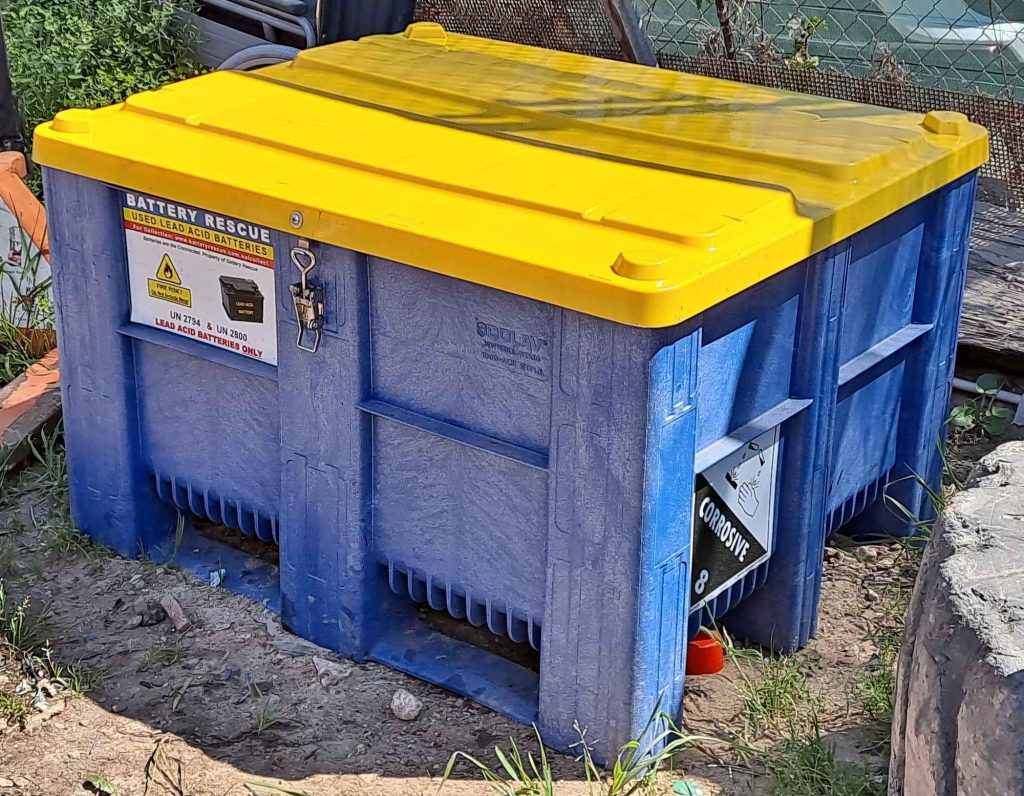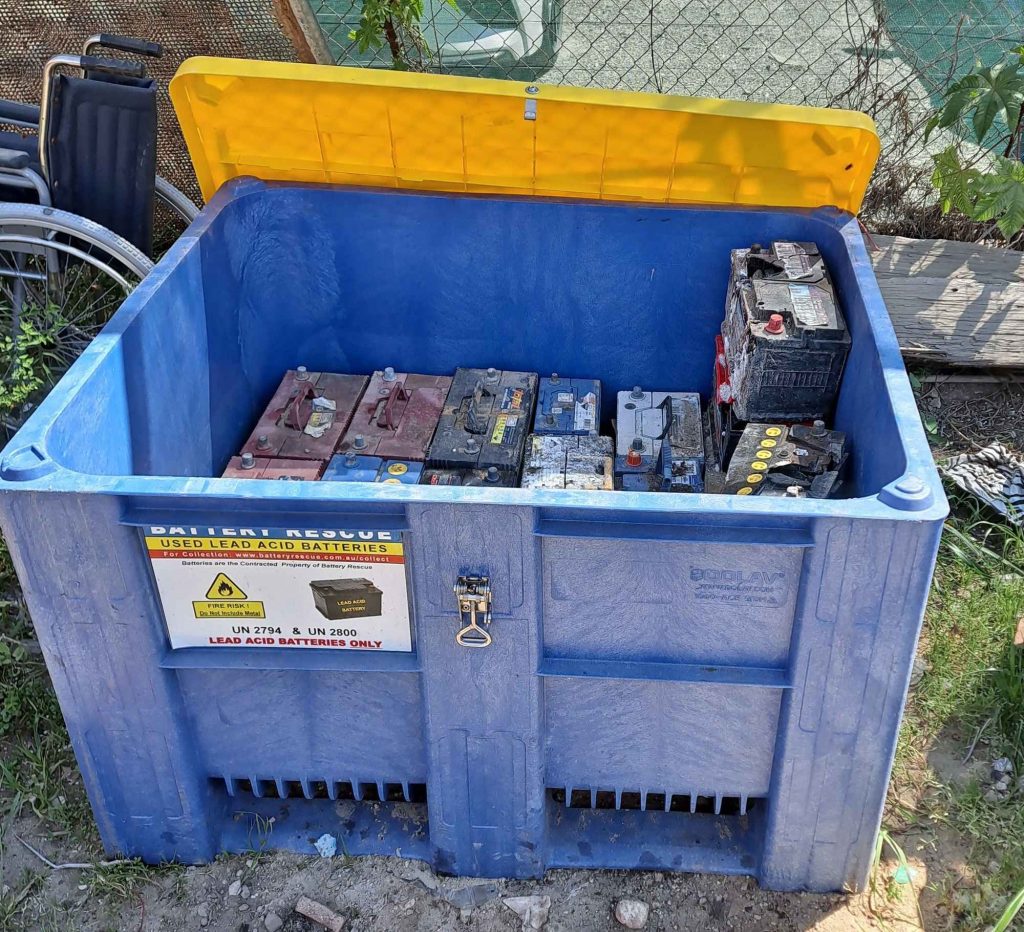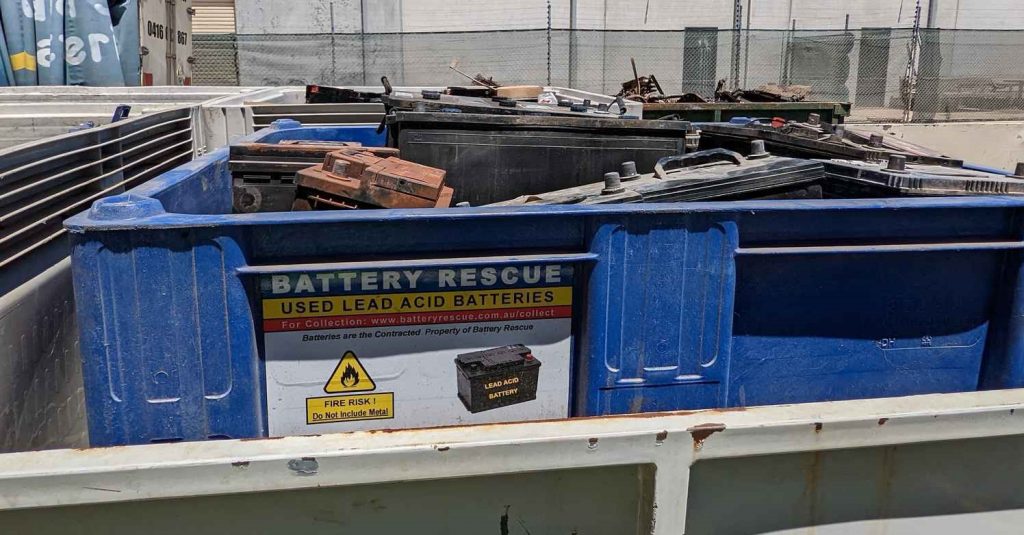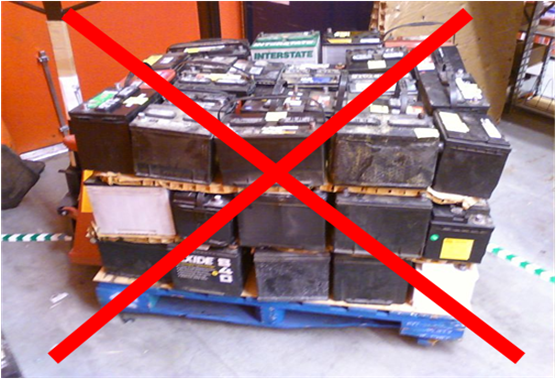Plastic Battery Bins, such as the one pictured below, are becoming increasingly popular for the transportation of used lead acid batteries (ULAB) destined for recycling and are widely used by the European lead acid battery recycling industry.
Recent changes (June 2018) by the UN Sub-Committee of Experts to the P801 Packing Instructions for transporting lead acid batteries, have clarified the requirements when using plastic bins. These changes were incorporated in edition 7.7 of the Australian Code for Transportation of Dangerous Goods by Road & Rail (ADGC)and became mandatory as of October 2021. Combined with the trends of safety and environmental sustainability we anticipate further growth in the use of plastic bins for the collection and recycling of used lead acid batteries (ULAB).
The use of plastic bins is in our opinion a significant improvement on the industry’s de facto standard, the wood pallet, however there are some disadvantages. Outlined below is a summary of what we see as the pros and cons of using plastic battery bins versus wood pallets.

Advantages Using Plastic Battery Bins
Transport Safety
A plastic battery bin generally provides a better means of securing the batteries during transport provided suitable means are used to prevent the bins losing their content (i.e use of an adequately secured lid). While there are no certification requirements for battery bins those used by the industry are generally heavy duty and well-constructed.
When using wood pallets, the packaging requirements are quite complex and difficult if you are dealing with different size batteries. Variations in worker’s attitudes and training, non-availability of the required materials / tools and the cost of performing this task, results in many unsafe battery shipments that do not complying with regulation requirements.
Improved Storage
A plastic battery bin provides a better means of storing batteries than a wood pallet, as it will capture any acid leaks. It provides more convenient options for applying suitable labelling to meet Dangerous Goods and Global Harmonisation System (GHS) requirements.
The battery bin can also be a safer method to secure and prevent accidents and if a suitable lid is used, it can be used for outdoor storage. This is often a requirement for workshops where space is limited.
There are still, however, fire risks if used lead acid batteries are incorrectly stacked in a plastic bin or are mixed with other battery chemistries. Please see Battery Safety – Reducing Their Fire Risk for information on how to safely store and transport batteries in plastic bins.
Reduced Environmental Impact
Due to age and handling ULAB frequently leak acid. A plastic battery bin will ensure any acid leaks are captured during both storage and transport to the recycling facility. The acid is recycled as sodium sulfate to be used in the manufacture of glass, textiles, laundry detergents and fertilisers.
Wood pallets are clearly inadequate for capturing any acid leaks. The battery acid is harmful to humans and the environment and contains high levels of entrained lead and other toxic heavy metals.
Heavy duty plastic bins are designed to be reused many times, where most wood pallets are used once or a few times before becoming unserviceable. In addition to the waste of the spent pallet, there is considerable waste generated in the form of plastic strapping and wrapping.
Simpler Packaging Requirements
Provided a few simple precautions are observed batteries are easier to stack and prepare for road or rail transport using a plastic bin than wood pallets. To meet the requirement of the Australian Code for the Transportation of Dangerous Goods by Road and Rail (ADGC), that measures must be taken to prevent the loss of contents, we would recommend the use of a suitably secured lid.
The other important requirement due to the potential fire risk posed by ULAB, is that measures must be taken to prevent short circuits. We would recommend that this can be best achieved by ensuring batteries are stack upright and snuggly together to prevent excessive movement during transport. Subsequent layers of batteries can be stacked directly on top of the underlying batteries, provided the battery’s outer casing is made of polypropylene (plastic not metal).

Simpler Regulation Compliance
The simpler storage and transport requirements when using plastic battery bins makes it easier for companies to meet the relevant environmental, safety and transport regulations.
Disadvantages Using Plastic Battery Bins
Safety Issues Loading
Batteries are heavy and some larger batteries can weigh up to 70kg each. There can be an Occupational Health & Safety (OSH) Risk associated with placing batteries inside a bin, depending upon the height of the bin’s side and the weight of the batteries being used. Simply dropping the battery into the bin to avoid bending your back creates other safety risks in terms of potential short circuits occurring during storage and transport.
Safety Issues Unloading
Often batteries collected in bins are consolidated and repackaged for transport along the collection supply chain. This will involve unpacking the batteries from the bin and repackaging them into another container or device, such as wood pallets. The manual unloading of batteries from battery bins is more difficult and a greater OSH risk than the initial loading phase.
If the battery bin is being delivered directly to a recycling facility where the batteries should be automatically unloaded into a hopper, then these OSH risks do not apply. Not all recycling facilities have the necessary equipment to accept and process batteries delivered in plastic battery bins.
Meeting The New Battery Packaging Requirements for Transport
The ADGC’s (edition 7.7) P801 Packing Instructions for lead acid batteries includes the following requirements when using a plastic battery bin for transporting batteries;
- The bins shall not be filled to a height greater than the height of their sides;
- Measures shall be taken to ensure that filled bins cannot lose their content;
The use of a lid is probably the most obvious way to ensure these 2 requirements are met. In practice, however, it can be difficult to ensure that users do not slightly overfill the bin where some batteries slightly protrude, preventing the use of a lid. An example of this problem is illustrated in the photo below and would take considerable time and effort to rectify.

Cost to Return Bins
Heavy duty plastic bins are more expensive than wood pallets and generally require being returned. There is a cost and effort in arranging their return which can be significant if the recycling facility is a long distance away. There is also the potential for the battery bins to be lost which is being recently mitigated through the use of GPS tracking technology.
Signage Dilemma
One of the appeals of using battery bins is the convenience of applying semi-permanent signage to meet storage and transport regulatory requirements. It is however an offence under the ADGC to transport an empty container / package displaying dangerous good markings and labels. This requires that the DG / GHS markings or labels to be covered or obscured when transporting the battery bins empty.
There are several different solutions to this dilemma which are beyond the scope of this article, but they do introduce extra complexity for users.
Conclusion
Despite some of the limitations of using plastic battery bins for the storage and transport of used lead acid batteries we are witnessing a clear trend for their increased usage by the battery recycling industry. We believe this will continue and that wood pallets, which are woefully inadequate for this purpose, will eventually be replaced.






